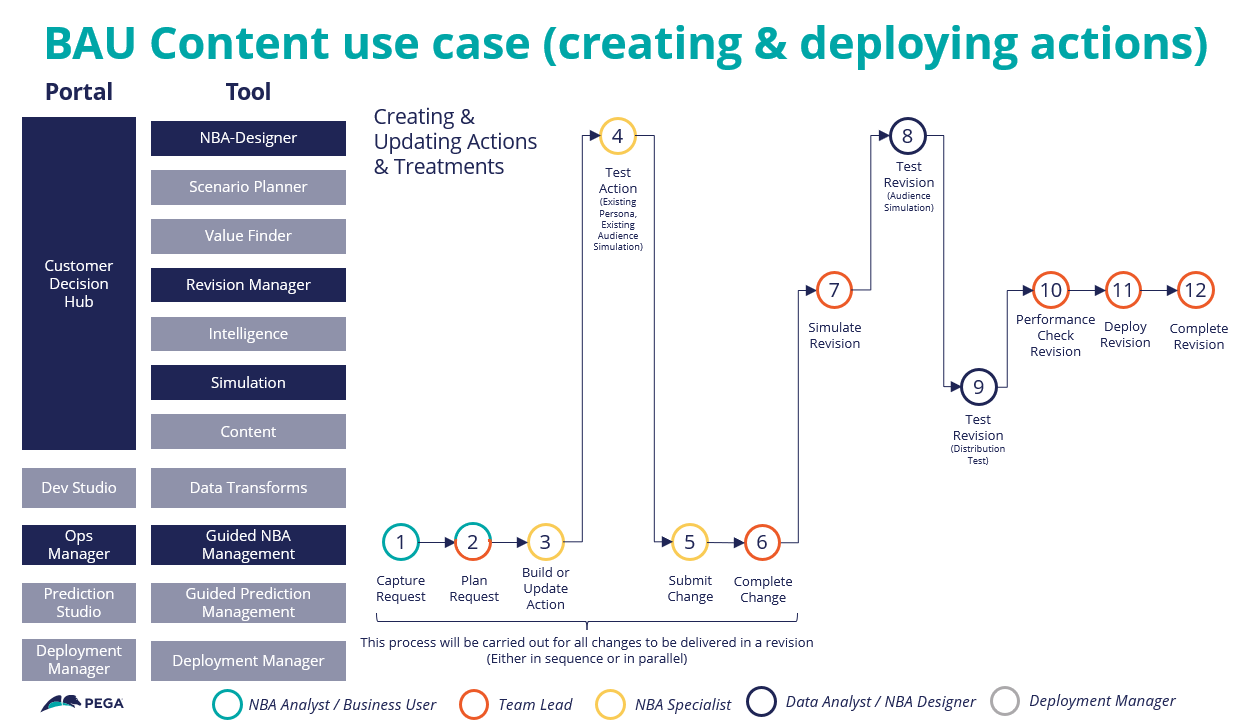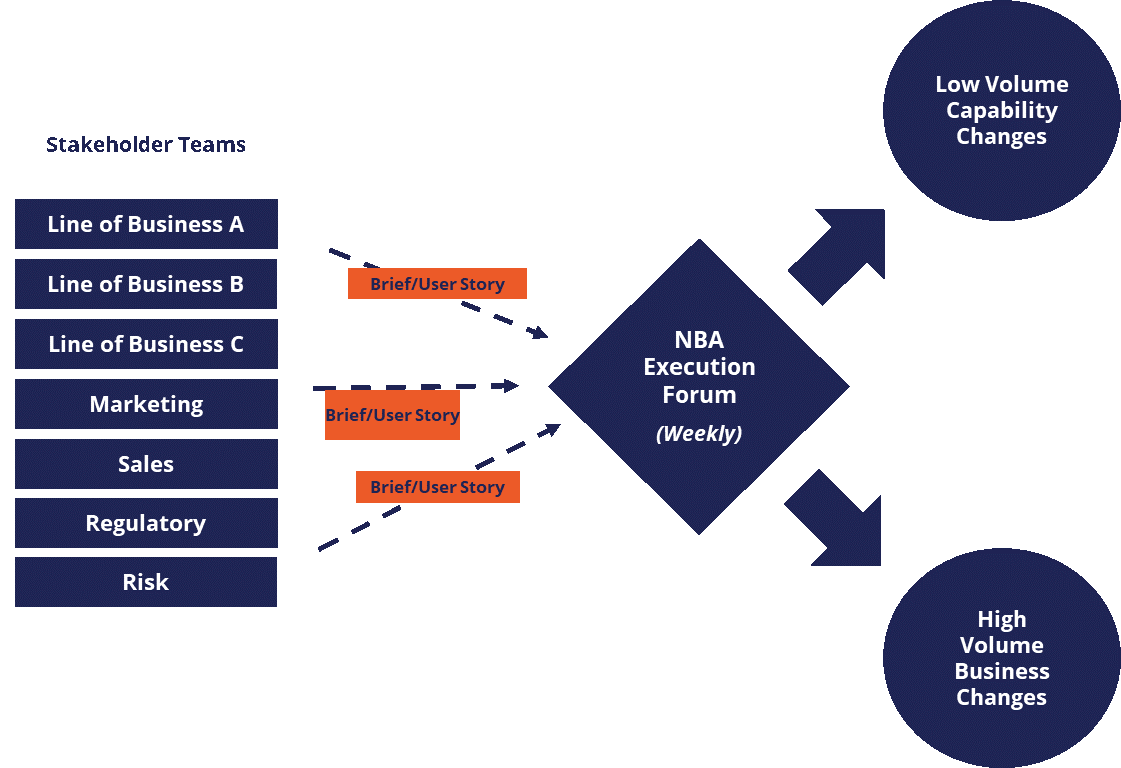This is the fifth blog in a series that dives deeper into how to implement the Pega Customer Decision Hub, end to end, and in the right way.
A Pega Customer Decision Hub™ project consists of four phases: Discover, Prepare, Build, and Adopt. This post covers the Adopt phase.
In an earlier post in this series I covered the Build phase, and explained how to set up your logic blueprint and configure the various properties using Next Best Action Designer. In that blog, I referred to the Adopt phase as “the people that manage the box, and the people that manage the people that manage the box."
The Adopt phase is about more than just traditional business readiness activities and going live. In this post, I will show you what your project’s end stage should look like and what's required to get there.
First, I’ll describe why we created the Adopt phase and its set of delivery tasks.
Why you must prioritize the Adopt phase
Often, I see Pega Customer Decision Hub projects where the Adopt phase is not deemed important. Sometimes teams don’t staff this phase or set it up properly (or at all). There is often the assumption that the current operational organization should just absorb the transformation. For example, we find some companies thinking, "our team will do the training once the software is there, and that will be sufficient.”
Let me discourage you from thinking this way. Sure, there are organizations that have worked in customer-centric ways well before beginning a Pega Customer Decision Hub implementation. But even in these circumstances, there are specificities to the way your organization can benefit the most from the implementation. I often see companies diverging from best practices in these three areas:
- Their company is organized by channel. This means that different channels have different teams that work with different KPIs, business rules, and even a completely different offer set. Getting these channel teams to work together will require effort.
- The company bases what it offers on a predetermined set of rules, (or just a post-it note hanging on the side of the agent screen). Using a real-time decisioning engine and adaptive modeling will often result in a different offer having to be presented on every new call by the agent. This will significantly change the agent's way of working. It will change their incentivization even more. You can imagine this is something that agents will be incredibly nervous about. It is their paycheck, right? So being clear up front about what they can expect, how they'll be impacted, and how this will improve (not worsen) their job, is paramount to successful adoption.
- Their marketing organization uses a waterfall approach when creating campaigns. When working with Pega Customer Decision Hub, we propose an Agile approach executed by a matrix organization and organized by business objectives (e.g., retention optimization) and functional areas (e.g., logic design). Multiple teams would typically work on the same Next Best Action Designer framework, and simulations would be done across all their changes to identify the expected outcome of one set of changes. We call this a revision, by the way.
The three pillars of the Adopt phase
When I think about the Adopt phase, I think about the following three categories:
- Agility: Adopt phase best practices ensure you have the right process to make changes. This is critical to get to market fast and to mitigate risk.
- Execution: Adopt phase best practices explain the roles and responsibilities of the operational teams at the core of the solution and how to enable them.
- Governance: Adopt phase best practices describe how the Pega Customer Decision Hub solution fits in with the broader organization, helping you create support, as well as decide on and prioritize large and small program changes.
Let’s dive deeper into each of these:
Agility
Pega built a portal called (1:1) Ops Manager that allows various roles and teams to work together to perform changes in a harmonious way. In the picture below, you’ll see the process flow of a typical use case (creating an offer or action) and the tools, portals, and roles involved. You see that most tasks are performed in the Ops Manager portal. There, you capture the request (1) and build it out directly (3), allowing you to unit test it (4). When this is all done well, the change ends up in the revision and you can perform the simulation against all changes in the set (7), upon which you can deploy the full set of changes (11).

Let’s explore the to-be team structure next. At the highest level, there is the governance board, which addresses low-volume capability changes (I will address these later in this blog,) and the operational teams, which cover high-volume daily business changes.

Execution
I want to focus on two teams here: the enterprise capabilities team and the business content team. These teams define, design, and deploy all the daily changes. However, these teams don’t live in a vacuum, and are typically part of an organization as visualized below. You can see that they have links to important teams in the broader organization, (e.g., IT, channel, and business users.)
To manage this team, the head of enterprise 1:1 engagement sits at the top. This person is accountable for the team and solution's performance, and for prioritizing demand from all business lines.

The two operational teams include full set of roles covering testing, data science, business transformation, data, and of course logic configuration. Each business content team consists of all these roles and handles a business area. You could see the enterprise capabilities team as a so-called “super team” that can address complex configuration requirements that the business content teams can’t address. I won’t dive into the detail of each of these roles, but follow the links at the end of this blog to find out more about them, their tasks, and their enablement paths!
Governance
As I described earlier, it is critical to have a team that sits across the marketing process and takes responsibility for high-level decisions and discussions. This governance board will meet regularly, but on a less frequent basis than the other teams (typically once a month). The purpose of this governing board is to control the overall strategy that the business wants to use to leverage the customer-centric, omni-channel approach to using Next Best Action. They will set the overall strategy, approach, and policies for the Next Best Action organization.
Usually, the governance board sits between three types of teams:
- The marketing P&Ls: The teams that own the offers and the benefits that are expected to be delivered.
- The channel management teams: The people that handle Next Best Action execution. They care about customer experience and operational KPIs, such as AHT (Average Handling Time) and service level.
- And, in many companies, the “risk team,” the internal finance teams, or the internal regulatory teams.
So, there we have it! We've discussed all four phases of the Pega Express delivery approach, specifically applied to a Pega Customer Decision Hub implementation. We addressed the organizational tasks, as well as the functional and technical, and showed that you need to execute them in unison.
I hope this blog was useful and provided an overview of everything involved. Most importantly, I hope it gave you the tools to get the work done in the best way.
The project might be done, but the program is not! If you want to know more about typical next steps, like upgrades, migrations, roadmap discussions, channel enablement, analytics, and other topics, keep following my blog series and check out our recommended resources for detailed information on each of these.
In upcoming blogs we’ll continue to dive deeper into the changes that need to take place across people, processes, and technology for an organization to experience the incredible business benefits of a Next Best Action engagement approach.
Recommended resources:
- Head to this wiki page to get all the details
- Take this Pega Academy training to learn more about how to deliver a Pega Customer Decision Hub project successfully, and which assets are available through Pega.
- View our webinar series, “The Ins and Outs of 1:1 Engagement” to learn how to connect conversations and build relationships.
- Download the whitepaper, “Crossing the chasm: From campaigns to always-on marketing,” to learn how 1:1 marketing helps increase customer value.
- Visit the Business Excellence page to access up-to-date reference materials on following best practices.
Don’t forget
JOIN THE CONVERSATION on Collaboration Center
FOLLOW @PegaDeveloper on Twitter
SUBSCRIBE to the Pega Developer Podcast on Spotify or via RSS

